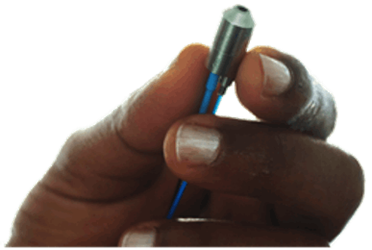Could Fiber Optic Probes Replace Traditional Biopsies?

Successfully miniaturized multimodal optical technology combines three nonlinear imaging techniques into one probe, said German scientists. Using advanced fiber optics and gradient index (GRIN) lenses, researchers said the technology is capable of producing high-resolution imaging sufficient for minimally-invasive endoscopic cancer diagnoses or surgical guidance systems.
The current gold standard in cancer diagnosis is the biopsy, a multi-step process that requires the surgical removal of suspicious tissue, which then is stained and evaluated under a microscope by a trained pathologist. From start to finish, the process is both painful and risky for patients, and can take several days to complete. Researchers have been investigating possible alternatives to invasive biopsies, such as liquid biopsies that look for disease biomarkers in the blood and advanced imaging techniques that can evaluate tissue without removing it.
In 2014, scientists from the University of Texas introduced a 3-in-1 optical cancer probe that could facilitate the early detection of skin cancer. Researchers from Rice University connected fiber optic cables to traditional endoscopes to improve the evaluation of esophageal lesions.
According to Jurgen Popp, scientist at the Leibniz Institute of Photonic Technology (LIPT), many current approaches to non-linear imaging in handheld cancer probes have loaded too many of the optical components into the head of the probe, which impedes miniaturization and makes the technology less biocompatible and less robust.
His team’s solution was to incorporate GRIN lenses developed at Grintech, which collaborated with Popp’s team to create a lens 1.8 millimeters in diameter that allows for continuous refractive index changes from within the lens material, according to a press release. A multicore fiber developed by Fujikura in Japan offers 10,000 light-guiding cores in a fiber a half a millimeter in diameter. The resulting probe is approximately the size of a ballpoint pen.
“Compared to other endoscopic nonlinear imaging approaches, our fiber probe stands out due to its simplicity, said Popp, lead author of a paper published in Optica. “Since no moving parts are incorporated in the probe head, possible misalignments in the optics are limited and the probe’s overall lifetime is increased.”
The device proposed by Popp’s team is capable of several types of non-linear imaging, including anti-stokes Raman scattering, second harmonic generation, and two-photon excited auto-fluorescence. Previous research led by Popp has demonstrated the value of these techniques in oncological applications.
Using several imaging techniques at once allows clinicians to evaluate tissue outside of the lab and without the help of the traditional staining techniques.
“The new probe serves as a miniaturized microscope that uses near-infrared lasers to investigate tissue, said Popp. “Different components of biological tissue react differently to the excitation lasers, and their unique response gives us information about the molecular composition and morphology within the tissue.”
Popp commented that image resolution from the probe is sufficient to visualize borders of tumors, and multimodal endoscopic techniques could allow surgeons to make quick decisions during operations. The team’s next step is to evaluate the efficacy of its probe with animal models.
Related, novel fiber optic technology developed at the University of Adelaide has produced a fiber optic camera that can be connected to a surgical needle to guide neurosurgeons through complex procedures.
